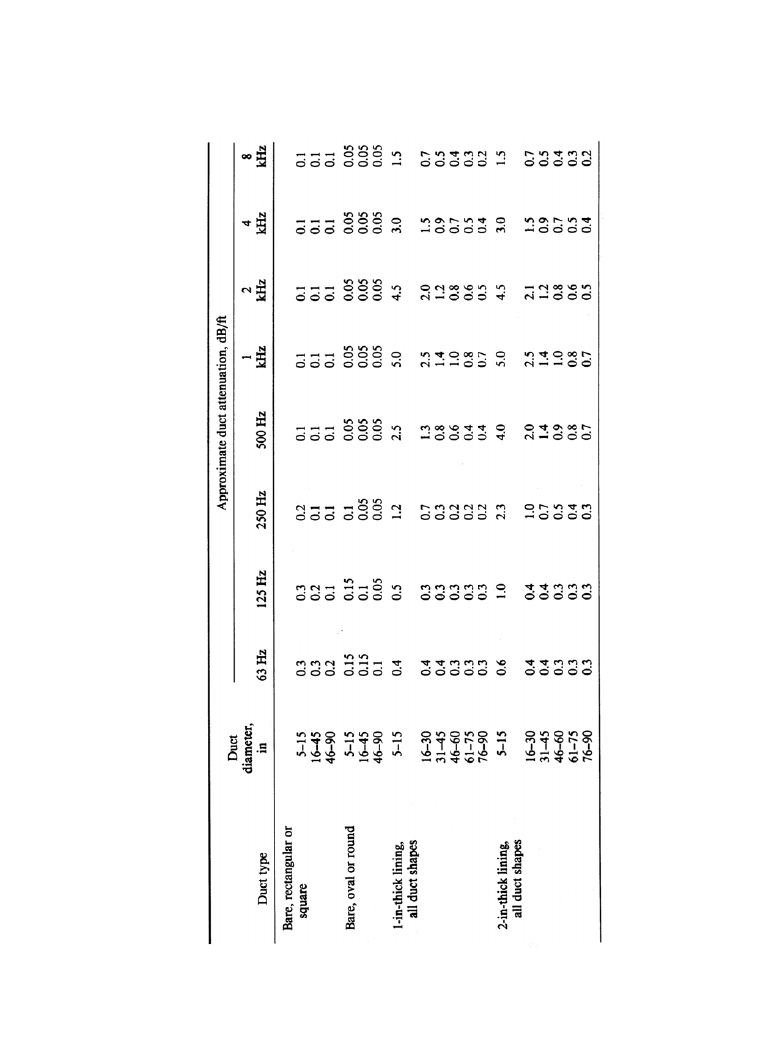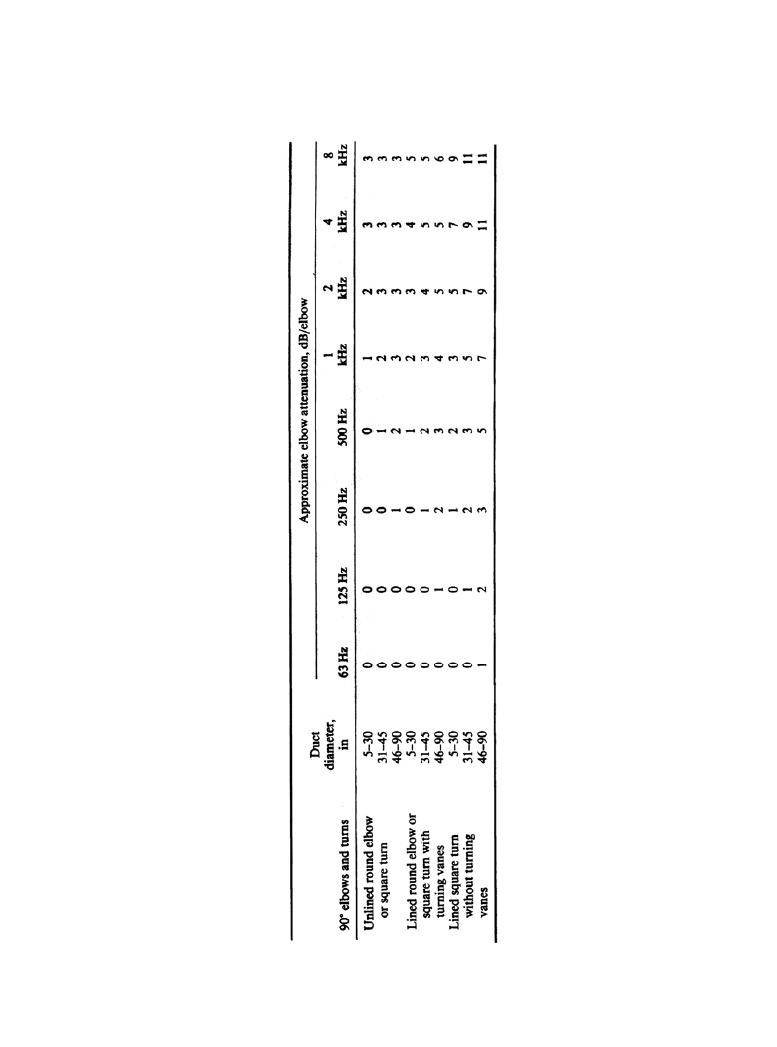ВУЗ: Казахская Национальная Академия Искусств им. Т. Жургенова
Категория: Книга
Дисциплина: Не указана
Добавлен: 03.02.2019
Просмотров: 21622
Скачиваний: 19

3-30 Architectural Acoustic Principles and Design Techniques
3.2.2c
Attenuation of Noise by Ducts
Various elements within the ducted ventilation system inherently provide some attenuation of the
noise as it travels through the ductwork, both down the supply-air system and up through the
return-air system. Certain elements, such as internal duct lining and prefabricated silencers, can
be added to the system as necessary to increase noise attenuation.
Bare ducts, that is, sheet-metal ducts which lack any added sound-absorptive lining, provide a
minimal but measurable amount of attenuation to the noise. The amount of attenuation depends
on such factors as width and height dimensions and the length of that section of ductwork under
consideration. Such duct attenuation is approximately 0.1 dB/ft of duct length for frequencies of
250 Hz and above regardless of width and height dimensions. For example, the 1000-Hz-band
noise level inside the end of a 10-ft length of bare rectangular duct should be approximately 1 dB
less than inside the beginning. For lower frequencies, duct attenuation is approximately 0.2 dB/ft
of duct length or even up to 0.3 dB/ft for ductwork as small as 5 to 15 in in either width or height.
Typical data are shown in Table 3.2.3. It is important to note that duct attenuation decreases in
the lower frequencies because the thin sheet metal of which most ductwork is constructed is a
poor barrier for low-frequency sound transmission, and as a result these low frequencies “break
out” of the ductwork and into the surrounding space. Thus, it is advisable to reroute ductwork
which is known to contain high levels of sound energy, especially low-frequency sound energy,
from spaces which require low background noise.
Sheet-metal duct may be lined with sound-absorptive material. This material is generally of
about 1 1/2 lb/ft density and of either 1- or 2-in thickness (the 2-in thickness generally provides
improved duct attenuation, which can be an important consideration, especially for low-fre-
quency noise control), and it often has a mastic facing to reduce shredding and deterioration
from high airflow velocities. For lined ductwork, duct attenuation is very much dependent on the
width and height dimensions, and on the octave frequency band of interest. Sources such as [3]
or specific manufacturers’ data should be consulted for a detailed analysis of lined-ductwork
attenuation. It should be noted that noise breakout, especially for low frequencies, is not signifi-
cantly affected by lining.
Splits, divisions, and takeoffs in the ductwork represent further attenuation to the ducted
noise. It is assumed that the amount of noise energy delivered is proportional to the amount of air
delivered. For example, if a fan that provides a total of 10,000 ft
3
/min of air delivers only 1000
ft
3
/min of air to a particular room (the other 9000 ft
3
/min of air is delivered to other rooms by
means of splits and divisions), the amount of air delivered to that room is reduced to 10 percent
of the total, whereas the noise or power level is reduced by 10 log (0.1) of the total. In other
words, the splits and divisions have reduced the amount of noise delivered to that room by 10 dB.
Similarly, a split which sends half of the air down one duct and the other half down another duct
has reduced the amount of noise entering each of these two ducts by 3 dB, which is derived from
10 log (0.5) = 3 dB.
Bends and elbows in ductwork are not very effective in attenuating low-frequency noise but
can provide significant attenuation of higher-frequency noise. Lined elbows and bends provide
better high-frequency attenuation than bare elbows and bends. Bare elbows may provide up to 3
dB of attenuation at 2000 Hz and above, and lined elbows can provide between 5 and 10 dB of
attenuation in the higher frequencies, depending on the elbow radius and duct diameter. Typical
data are shown in Table 3.2.4.
Downloaded from Digital Engineering Library @ McGraw-Hill (www.digitalengineeringlibrary.com)
Copyright © 2004 The McGraw-Hill Companies. All rights reserved.
Any use is subject to the Terms of Use as given at the website.
Criteria for Acceptability of Acoustical Performance

Criteria for Acceptability of Acoustical Performance 3-31
T
a
b
le 3.
2.
3 Ap
p
ro
xi
m
at
e
D
u
c
t
A
tt
e
n
u
a
ti
o
n
Downloaded from Digital Engineering Library @ McGraw-Hill (www.digitalengineeringlibrary.com)
Copyright © 2004 The McGraw-Hill Companies. All rights reserved.
Any use is subject to the Terms of Use as given at the website.
Criteria for Acceptability of Acoustical Performance

3-32 Architectural Acoustic Principles and Design Techniques
T
a
b
le 3.
2.
4 ap
p
ro
x
im
a
te
E
lb
o
w
A
tt
en
u
a
ti
o
n
Downloaded from Digital Engineering Library @ McGraw-Hill (www.digitalengineeringlibrary.com)
Copyright © 2004 The McGraw-Hill Companies. All rights reserved.
Any use is subject to the Terms of Use as given at the website.
Criteria for Acceptability of Acoustical Performance

Criteria for Acceptability of Acoustical Performance 3-33
3.2.2d
Duct Silencers
Prefabricated duct silencers generally incorporate a system of parallel sound absorptive baffles
between which the air must flow (Figure 3.2.3). Silencers are available in a wide range of sizes
and duct attenuations which tend to vary with frequency. Manufacturers should be able to pro-
vide detailed data on the performance of their silencers. These data should include the octave-
band dynamic insertion loss (DIL), the pressure drop across the silencer, and the self-generated
noise of the silencer. The effective attenuation of a silencer in any given octave band can change
with the airflow velocity through the silencer. This is measured in terms of the DIL, which is
duct attenuation in octave bands at different airflow velocities, both positive and negative. Posi-
tive DILs rate the effectiveness of a silencer when the noise and the air both flow in the same
direction, as in the case of a supply-air system, and negative DILs apply where noise flows in the
opposite direction of the airflow as in a return-air system. Because the baffles in a silencer
restrict the flow of air to a certain degree, the silencer can add to the static pressure against which
the fan must work, so that the pressure-drop ratings of silencers can become an important consid-
eration. Since the baffles generate a certain amount of turbulence in the airflow, silencers can
generate a certain amount of noise. Silencers should be positioned so that the amount of attenu-
ated noise leaving them is still higher than the generated noise of the silencers, which implies
that the silencers should be placed relatively close to fans. On the other hand, it is good practice
to locate silencers at least five duct diameters downstream of a fan in the supply-air system; oth-
erwise noise generated by turbulent air, especially low-frequency noise, can greatly exceed the
rated self-noise of the silencers. Placement of silencers in return-air systems is less critical, but a
spacing of at least three duct diameters between fan and silencer is still advisable.
Figure 3.2.3
Cutaway view of a typical duct silencer.
Downloaded from Digital Engineering Library @ McGraw-Hill (www.digitalengineeringlibrary.com)
Copyright © 2004 The McGraw-Hill Companies. All rights reserved.
Any use is subject to the Terms of Use as given at the website.
Criteria for Acceptability of Acoustical Performance

3-34 Architectural Acoustic Principles and Design Techniques
3.2.2e
Calculating Resultant Sound Levels
A convenient method for determining the sound power levels that enter a room is to list the
noise-generating and noise-attenuating devices in the ductwork system sequentially, beginning
with the fan. This should be done for both supply-air systems and return-air systems. The follow-
ing analysis should be performed octave band by octave band.
For each device, calculate either the sound power levels generated or the amount of attenua-
tion provided by each element. Then sequentially subtract the attenuation provided by each ele-
ment until a noise-generating device is encountered. At this point, the resultant sound power
level which has made its way through the ductwork should be added to the sound power level
generated by the appropriate device. Continue with this method until the octave-band sound
power levels at the end of the run of ductwork (at the point at which the sound begins to enter the
room) have been calculated. Then convert the sound power levels to sound pressure levels at var-
ious points of concern within the room.
The resultant octave-band sound pressure levels then may be plotted against NC curves, such
as in Figure 3.2.2, in order to determine whether the ventilation-system noise satisfies the crite-
rion decided upon for the appropriate space. If the levels are too high, noise attenuation devices
may be incorporated in the ventilation system. The calculation procedure may then be repeated
to take into account the effect of the attenuation devices. If an attenuation device is inserted into
the system, it is important to delete the effect of the part of the system which has been omitted.
For example, if a 5-ft-long attenuator is inserted in a length of lined duct, then the effect of 5 ft of
lined duct should be eliminated from subsequent calculations. Otherwise the calculations may
result in inappropriately low sound pressure levels.
3.2.3
References
1.
ANSI: Method for the Measurement of Monosyllabic Word Intelligibility, ANSI S3.2-1960,
rev. 1977, American National Standards Institute, New York, N.Y., 1976.
2.
ANSI: American National Standard.for Rating Noise with Respect to Speech Interference,
ANSI S3.14-1977, American National Standards Institute, New York, N.Y., 1977.
3.
ASHRAE: ASHRAE Handbook—1984 Systems, American Society of Heating, Refrigerat-
ing and Air-Conditioning Engineers, Atlanta, Ga., 1984.
4.
Beranek, L. L.: Noise and Vibration Control, McGraw-Hill. New York, N.Y., 1971.
Downloaded from Digital Engineering Library @ McGraw-Hill (www.digitalengineeringlibrary.com)
Copyright © 2004 The McGraw-Hill Companies. All rights reserved.
Any use is subject to the Terms of Use as given at the website.
Criteria for Acceptability of Acoustical Performance